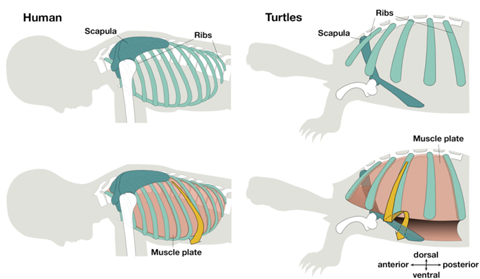| RIKEN Center for Developmental Biology (CDB) 2-2-3 Minatojima minamimachi, Chuo-ku, Kobe 650-0047, Japan |
July 10, 2009 – The elephant’s trunk, the giraffe’s neck, the bat’s wing all provide examples of how evolution tinkers with preexisting body parts, giving rise to adaptations that are simultaneously new and familiar. But there are also cases in which a novelty enters the body plan without evident precursors, defying explanation by such bricolage. The turtle’s shell, or carapace, is one such invention; it appears to have burst into the fossil record with almost no prior inkling of its emergence.
New work by Hiroshi Nagashima and coworkers in the Laboratory for Evolutionary Morphology (Shigeru Kuratani; Group Director) now shows that the musculoskeletal changes that led to abrupt appearance of the turtle shell involved a combination of altered tissue folding and new connectivity. And, by analyzing the structure of a proto-turtle fossil recently unearthed in China, the group reveals an intermediate body plan between that of ancient uncarapaced reptiles in the same lineage and the turtles, tortoises, and terrapins of today. Nagashima began by making anatomic comparisons of mouse, chicken and turtle embryos at the stages in development at which structural changes that underlie the formation of the carapace first become apparent. Specifically, the group focused on how connections between muscles associated with the ribs and scapulae might differ in turtle and other vertebrate embryos, for although it is known that the shell itself forms through the fusion of externalized ribs, the developmental steps that lead up to this novel structure have been unclear. What Nagashima found was that, despite the radically different modified appearance of the adult turtle, the changes to the embryo are in fact quite modest. In contrast to the bird and mammal, the embryonic turtle’s scapula forms anterior to the ribs, and the muscles that attach to these bones maintain their connectivities. The ribs themselves are shorter, confined to the axial (underarm) region, meaning that they can only grow to the sides and anterior of the embryo, eventually covering the scapula. The cause of this “axial arrest” of the ribs remains uncertain, but it is this change in rib growth coupled with altered folding of tissue at the axis and body wall that fundamentally distinguishes the turtle from other vertebrates. A second innovation the group identified was a number of new attachment points among what are known as “in-and-out muscles,” which primarily connect limbs to the trunk. They found that muscles in the turtle’s upper thoracic region, such as the pectorals and the latissimus dorsi, arose more anteriorly and established different connectivities to bones than those seen in chicken and mouse. The insights into turtle musculoskeletal development gained from comparisons with extant animals mesh well with the perspective provided by fossils of extinct species from the lineage that led to the turtles. The skeleton of the most ancient known turtle, Odontochelys, which was first described in 2008, shows that axial arrest of the ribs had already begun 220 million years ago. The ribs, however, did not show the splayed arrangement seen in the ribs of modern turtles, nor did they fuse to form a full carapace. “In this study, we used fossil evidence to develop comparisons in the skeletal architecture of modern turtles and their ancestors, but the question of muscle homologies remains unanswered, due to the lack of soft tissue," says Kuratani. "But we feel that a general knowledge of the vertebrate developmental plan will still also us to draw reasonable conclusions about how at least some of the muscles might have connected to the skeleton in the most ancient turtles, via an evolutionary developmental biology approach that we feel may find broader application among paleontologists." |
|||||
|
|||||
|
|||||
 |
| Copyright (C) CENTER FOR DEVELOPMENTAL BIOLOGY All rights reserved. |
